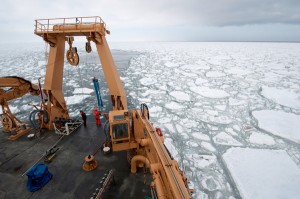Bering Sea chill yields fatter plankton, pollock diet changes
December 8, 2010

Carin Stephens
907-322-8730
12/8/10
Despite a 30-year warming trend, the last three years in the Bering Sea have been the coldest on record. A University of Alaska Fairbanks scientist says that the cold temperatures have helped produce larger zooplankton in the Bering Sea, which may affect the way Walleye pollock feed.
Alexei Pinchuk, research professional at the UAF Seward Marine Center, has spent the last three years gathering zooplankton samples in the Bering Sea. He and his colleagues have been looking at how changes in temperature in the Bering Sea affect resident zooplankton and, in turn, how those zooplankton shifts may affect the diet of Walleye pollock.
During colder years, like the last three, pollock tend to eat the larger zooplankton, like copepods and krill, which flourish in chillier temperatures. Pinchuk has also found that the recent cold temperatures have brought an arctic “sand-flea”, the amphipod Themisto libellula, south into Bering Sea waters. Young salmon and pollock seem to prefer to eat these amphipods over other smaller zooplankton.
In warmer years, which include the record-setting high temperatures of 2001 to 2005, smaller zooplankton tend to thrive. According to Pinchuk and his colleagues, younger pollock tend to eat the smaller plankton, while larger pollock favor the larger plankton found in colder waters. This causes younger pollock to start out doing well in warmer temperatures, but as the pollock grow bigger, they may not be able to find the larger zooplankton prey they need to produce enough fat for overwintering.
“The larger pollock may then eat their smaller cousins instead,” said Pinchuk.
Pinchuk conducted his research on board the U.S. Coast Guard Cutter Healy, R/V Knorr and R/V Thomas G. Thompson. He collected his zooplankton samples using multiple collecting nets.
Although the last few years have been cold, scientists predict that the warming trend in the Bering Sea will continue.
Pinchuk’s findings were featured in the Nov. 4 issue of Nature magazine. His work is part of the broad Bering Sea Project, a six-year, $52 million integrated ecosystem study of the Bering Sea. The Bering Sea Project is funded by both the National Science Foundation and the North Pacific Research Board.
About the UAF School of Fisheries and Ocean Sciences
The UAF School of Fisheries and Ocean Sciences conducts world-class marine and fisheries research, education and outreach across Alaska, the Arctic and Antarctic. 60 faculty scientists and 150 students are engaged in building knowledge about Alaska and the world's coastal and marine ecosystems. SFOS is headquartered at the University of Alaska Fairbanks, and serves the state from facilities located in Seward, Juneau, Anchorage and Kodiak.
ADDITIONAL CONTACTS: Alexei Pinchuk, research professional, UAF Seward Marine Center, 907-224-4313, aipinchuk@alaska.edu.
ON THE WEB: www.sfos.uaf.edu
CS/12-8-10/109-11


